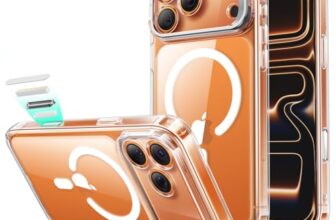Apple AirPods Max Technical Review: A Masterclass in Computational Audio and Industrial Design
Introduction: The Reimagination of the Personal Listening Experience
In the highly competitive landscape of premium personal audio, the introduction of a new flagship product from Apple is not merely an event; it is a paradigm shift that commands the attention of audiophiles, technologists, and design aficionados alike. The Apple AirPods Max are not just a larger version of their iconic in-ear counterparts. They represent the culmination of Apple’s years of research into acoustic engineering, material science, and, most critically, computational audio. This is not just a pair of headphones; it is a sophisticated, wearable audio computer, a device that seeks to redefine the very relationship between the listener and their soundscape. It is an audacious statement, a product that eschews the plastic-dominated conventions of the market in favor of an uncompromising vision built from aluminum, steel, and acoustically engineered textiles.
The philosophy underpinning the AirPods Max is one of total integration, where custom-designed hardware and powerful, intelligent software work in a seamless, symbiotic relationship. At its core is the potent combination of Apple’s custom dynamic drivers and the powerful H1 chip, working in concert to deliver a listening experience that is not just high-fidelity, but also contextually aware, immersive, and deeply personal. This is a product that promises not only to reproduce your music with breathtaking clarity but also to intelligently silence the world around you with pro-level Active Noise Cancellation, to place you in the center of a three-dimensional sound field with Personalized Spatial Audio, and to integrate into your digital life with the “magical,” frictionless experience that has become an Apple hallmark. Now updated with a versatile USB-C charging port and available in a range of five fresh colors, it is as much a statement of personal style as it is a piece of high-end audio equipment. And with a limited-time 9% discount, the entry point to this pinnacle of personal audio is more compelling than ever.
This exhaustive technical review will perform a granular dissection of the technologies and design principles that define the AirPods Max. We will deconstruct the complex algorithms behind the H1 chip’s computational audio engine, analyze the acoustic science of its pro-level noise cancellation and Transparency Mode, explore the biomechanics of its Personalized Spatial Audio, and examine the meticulous material choices that contribute to its unique acoustic-first design. This is a deep dive for the discerning user who demands to understand the science behind the sound and the engineering behind the elegance, to discover why the AirPods Max are not just another pair of headphones, but a landmark achievement in personal audio technology.

A Deep Dive into the Key Features: A Component-by-Component Technical Analysis
The AirPods Max’s flagship performance is not the result of a single component but the deeply integrated and synergistic operation of its custom hardware and advanced software, orchestrated by the powerful H1 chip in each earcup. Let’s analyze each core technology from a technical perspective.
-
The Sonic Engine: Computational Audio and High-Fidelity Drivers
The “ultimate over-ear listening experience” begins with a foundation of superb acoustic hardware. The AirPods Max feature an Apple-designed 40mm dynamic driver in each earcup. From an engineering standpoint, this driver is a marvel of efficiency and control. It employs a dual-neodymium ring magnet motor, a design typically found in high-end floor-standing speakers. This powerful motor system is capable of driving the diaphragm with extreme precision, maintaining a total harmonic distortion (THD) of less than 1 percent across the entire audible frequency range, even at maximum volume. This is the key to delivering “high-fidelity audio”: the bass is deep, rich, and impactful without becoming muddy; the mid-range is clear and present without coloration; and the high-frequency extension is crisp and detailed without being harsh.
However, the hardware is only half the story. The true innovation is Computational Audio. Each earcup contains a powerful 10-core Apple H1 chip, capable of performing 9 billion operations per second. This immense processing power is used to run a suite of real-time audio algorithms that refine and optimize the sound. The most critical of these is **Adaptive EQ**. Inward-facing microphones inside each earcup measure the sound you are actually hearing. The H1 chip then analyzes this signal in real-time and adjusts the low and mid-frequencies to account for the unique fit and seal of the ear cushions against your head. This means that whether you wear glasses, have different hair, or simply shift the headphones on your head, the sonic character of the audio remains consistent and true to the source. This “breakthrough listening experience” is the result of a perfect marriage between custom acoustic design and powerful, intelligent software.

-
Silence and Awareness: Pro-Level Active Noise Cancellation and Transparency Mode
The AirPods Max deliver a class-leading Active Noise Cancellation (ANC) experience through a sophisticated multi-microphone system. Each earcup is equipped with a total of nine microphones: eight are dedicated to ANC, and three are used for voice pickup (with two being shared with ANC). The system operates on a hybrid feed-forward and feed-back principle:
- Feed-Forward Cancellation: Six outward-facing microphones continuously sample the ambient noise of your environment. The H1 chip analyzes this external soundwave, computationally inverts its phase by 180 degrees, and generates an “anti-noise” signal that cancels the external sound before you ever hear it.
- Feed-Back Cancellation: Two inward-facing microphones inside the earcups listen for any residual noise that has managed to leak past the passive seal. This feedback loop allows the H1 chip to make instantaneous micro-adjustments to the cancellation signal, correcting for variations in fit and head movement.
The immense processing power of the H1 chip allows this entire process to happen hundreds of times per second, resulting in a level of noise reduction that is profoundly effective, particularly at canceling out the constant, low-frequency drone of airplane engines, trains, and air conditioners. This is what allows you to “immerse yourself in music.” Conversely, Transparency Mode uses the same external microphones to intelligently pipe the sound of the outside world *into* the headphones. The processing is so fast and the audio reproduction so natural that it creates the uncanny illusion that you aren’t wearing headphones at all, allowing you to “comfortably hear and interact with the world around you” without ever taking them off.

-
Acoustic Immersion: Personalized Spatial Audio with Dynamic Head Tracking
Personalized Spatial Audio is Apple’s most ambitious computational audio feature, designed to transform a standard stereo or multi-channel signal into a three-dimensional, cinema-like soundscape. The “Personalized” component is a key scientific innovation. Our brain determines the direction of a sound based on the subtle changes to the soundwave caused by the unique physical shape of our head and ears. This is known scientifically as a Head-Related Transfer Function (HRTF). Using the **TrueDepth camera on an iPhone**, the AirPods Max system guides you through a quick 3D scan of your ear’s geometry. This biometric data is used to generate a unique, personal HRTF for you, which is then synchronized across your devices.
When you listen to compatible content (such as movies with **Dolby Atmos** or specially mixed music tracks), the H1 chip applies your personal HRTF to the audio signal in real-time, tailoring the 3D audio rendering to your specific anatomy. This dramatically increases the accuracy and realism of the spatial effect, making it feel as though the sound is truly coming from distinct points in the space around you. The experience is made even more immersive by dynamic head tracking. Using the built-in gyroscopes and accelerometers in the AirPods Max, the system tracks the precise movement of your head relative to your source device (like an iPhone, iPad, or Mac). As you turn your head, the H1 chip remaps the entire sound field to keep the audio “anchored” to the screen. This creates the powerful illusion that the dialogue is coming directly from the actor’s mouth on screen, not from the headphones on your head, delivering an “immersive listening experience that places sound all around you.”

-
The Science of Comfort: An Acoustic-First, Material-Forward Design
The design of the AirPods Max is a radical departure from conventional headphone construction, with every material chosen for both its aesthetic and acoustic properties. The headband, or knit-mesh canopy, is a brilliant piece of ergonomic engineering. It is designed to distribute the headphone’s weight (384.8 grams) evenly across the top of the head, significantly reducing the localized pressure point that can cause discomfort during long listening sessions. The stainless steel frame is both durable and flexible, telescoping with a smooth, precise action to accommodate a wide range of head sizes. The anodized aluminum earcups are not just for looks; the rigid, non-resonant material provides an ideal housing for the dynamic drivers, minimizing unwanted vibrations. The earcups attach to the headband via a “revolutionary mechanism” that allows them to independently pivot and rotate to conform to the unique contours of the user’s head.
The memory foam ear cushions are a critical component of the “acoustic-first design.” The acoustically engineered memory foam is designed to create a gentle but firm seal around the ear. This passive seal is the first line of defense against outside noise, and it is also essential for creating a consistent acoustic chamber for the driver to perform optimally, especially for bass response. The cushions are wrapped in a custom-designed mesh textile that provides exceptional softness and breathability. A particularly clever piece of design is that the ear cushions are magnetically attached, making them incredibly easy to remove for cleaning or to replace with a different color for a touch of personalization.

-
Intuitive Tactility: The Digital Crown and USB-C Charging
Instead of relying on ambiguous touch controls or a cluster of small buttons, the AirPods Max feature a single point of “Precision Control”: the Digital Crown, a concept borrowed from the Apple Watch. This is a brilliant piece of human-interface design. The Digital Crown is a multi-function rotary encoder. Rotating it provides precise, tactile control over the volume. A single press can play/pause audio or answer/end a call. A double-press skips forward, and a triple-press skips back. A press-and-hold activates Siri. A separate, dedicated button allows for easy switching between ANC and Transparency mode. This physical, tactile interface is incredibly intuitive and provides a level of precision and reliability that touch controls often lack.
The latest version of the AirPods Max has been updated with a USB-C connector for charging. This is a significant convenience upgrade, aligning the headphones with the charging standard of the latest iPhones, iPads, and MacBooks. This allows users to carry a single cable and power adapter to charge all their primary Apple devices, simplifying travel and reducing cable clutter. The battery itself provides up to 20 hours of listening time on a single charge with ANC or Transparency mode enabled.

Pros: The Undeniable Technical Strengths
- Flagship-Level High-Fidelity Audio: The combination of the custom 40mm dynamic driver and the H1-powered computational audio (especially Adaptive EQ) delivers a sound signature that is rich, detailed, and impeccably balanced.
- Best-in-Class Noise Cancellation and Transparency: The sophisticated multi-microphone hybrid ANC system provides a profound level of silence, while the Transparency Mode is arguably the most natural-sounding on the market.
- Revolutionary Immersive Audio: Personalized Spatial Audio with dynamic head tracking creates a breathtakingly realistic and engaging 3D sound experience that is a true technological marvel.
- Uncompromising and Innovative Industrial Design: The use of premium materials like aluminum, steel, and knit mesh provides a unique aesthetic, exceptional comfort, and a durable, high-quality feel.
- Superb Ergonomics and Control: The Digital Crown is a brilliantly intuitive and precise physical interface, and the acoustic-first design with its memory foam cushions provides outstanding long-term comfort.
- Seamless and “Magical” Ecosystem Integration: Effortless one-tap pairing, automatic device switching, and audio sharing create a frictionless and deeply integrated user experience for those within the Apple ecosystem.

Cons: Important Technical Considerations and Limitations
- Lack of High-Resolution Audio Codec Support: The AirPods Max rely on the standard Bluetooth AAC codec. They do not support higher-bandwidth, “lossless” codecs like aptX HD, aptX Lossless, or LDAC, which is a significant omission for audiophiles using non-Apple or high-resolution audio sources.
- No Analog Audio Input: The headphones have no traditional 3.5mm audio jack. To listen to a wired source, one must purchase a separate, proprietary Lightning-to-3.5mm or USB-C-to-3.5mm audio cable from Apple, which involves a digital-to-analog conversion.
- Weight: At 384.8 grams, they are significantly heavier than most of their competitors, which are typically made from plastic. While the headband design is excellent at distributing this weight, it is still a noticeable factor.
- The Smart Case: The included Smart Case offers minimal physical protection and its primary function—to put the headphones into an ultra-low-power state—has been a point of contention and confusion for users who prefer a simple on/off button.
- Premium Price Point: They are positioned at the very top of the consumer headphone market, representing a significant financial investment.
Conclusion: The Apex Predator of Personal Audio Technology
The Apple AirPods Max are a statement product in the truest sense of the word. They are a bold, uncompromising, and brilliantly executed vision of what a premium personal listening device can be. Apple has leveraged its vertical integration of hardware, software, and silicon to create a product that is not just a collection of features, but a cohesive and intelligent experience. The audio performance is, in a word, exceptional. The Active Noise Cancellation is profoundly effective, and the Transparency Mode remains the industry’s benchmark for realism. But it is the computational audio features, particularly the jaw-droppingly immersive Personalized Spatial Audio, that elevate the AirPods Max from a great pair of headphones into a category of their own.
The industrial design is a polarizing yet undeniably premium affair, a testament to a meticulous focus on material science and acoustic principles. While they come with a flagship price tag and make some characteristically “Apple” decisions (like the lack of an analog input or a traditional power button), the sheer technical prowess and the seamless, “magical” experience they offer within the Apple ecosystem are undeniable. For the Apple user who is a discerning audiophile, a frequent traveler, or a remote worker who demands the absolute best in audio fidelity, noise cancellation, and call quality, the AirPods Max are not just a top choice; they are the apex predator of the personal audio world. They are an investment in a superior sensory experience, and they deliver on that promise with breathtaking competence.
Frequently Asked Questions (FAQs)
- Q1: What is the main technical difference between the H1 chip in the AirPods Max and the H2 chip in the AirPods Pro 2?
- A: The H2 chip is the newer, more powerful generation of Apple’s headphone silicon. Its primary advantage is a massive increase in computational power, allowing it to run more complex audio algorithms at a much faster rate. This is why the AirPods Pro 2 can offer “2x more” noise cancellation and more advanced, real-time features like Adaptive Audio and Conversation Awareness, which are not present on the H1-powered AirPods Max.
- Q2: Can I use the AirPods Max with an Android phone or a Windows PC?
- A: Yes, you can. The AirPods Max will function as a very high-quality pair of standard Bluetooth headphones when paired with a non-Apple device. You will be able to use the core features of Active Noise Cancellation and Transparency Mode (controlled by the button on the earcup). However, you will lose all the deep ecosystem integration features, such as one-tap pairing, automatic device switching, Audio Sharing, and, most importantly, Personalized Spatial Audio.
- Q3: How does the Digital Crown work, and is it better than touch controls?
- A: The Digital Crown is a physical, rotating dial with a push-button function, borrowed from the Apple Watch. It provides precise, tactile, and error-proof control. Rotating it changes the volume with satisfying physical feedback, and pressing it gives a definitive click. Many users find this more reliable and less prone to accidental inputs than the swipe-and-tap gestures of touch controls, especially when wearing gloves or in a hurry.
- Q4: Is it true that the AirPods Max don’t have a power button? How do I turn them off?
- A: That is correct. The AirPods Max do not have a traditional on/off button. They are designed to be in a constant state of readiness. When you take them off your head, they automatically pause the audio and enter a low-power mode. To put them into an “ultra-low-power” sleep state to conserve the battery for an extended period, you must place them in their included Smart Case.
- Q5: What is the technical benefit of the knit-mesh canopy headband over a traditional padded headband?
- A: A traditional padded headband concentrates the entire weight of the headphones onto a narrow strip across the top of your head. Over time, this can create a significant pressure point, leading to discomfort. The knit-mesh canopy is a tensioned, breathable fabric that acts like a suspension system. It distributes the weight of the aluminum earcups evenly across a much larger surface area of your head, which dramatically reduces localized pressure and makes the relatively heavy headphones feel much lighter and more comfortable during long listening sessions.
- Q6: Can I listen to lossless audio with the AirPods Max?
- A: This is a complex technical question. Wirelessly, no. The Bluetooth AAC codec used by the AirPods Max is not capable of transmitting true, bit-perfect lossless audio. To listen to Apple Music’s highest quality Lossless and Hi-Res Lossless formats, you must use a wired connection. This requires purchasing Apple’s proprietary USB-C to 3.5mm audio cable and an external Digital-to-Analog Converter (DAC), as the cable itself performs an ADC/DAC conversion that is not bit-perfect lossless.
See more posts in the category Headphones.







